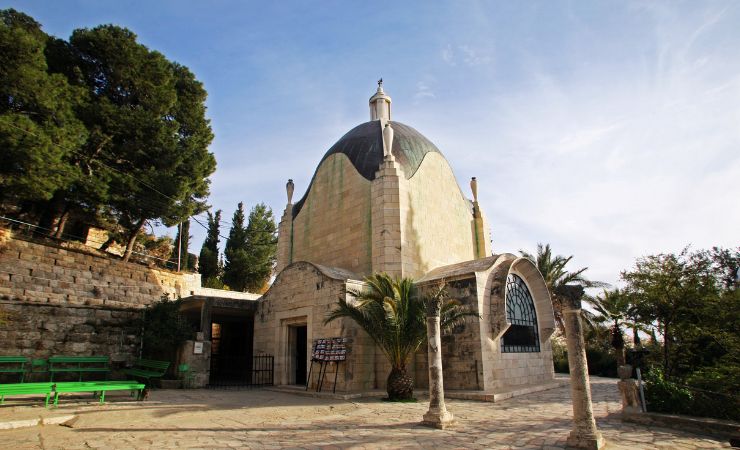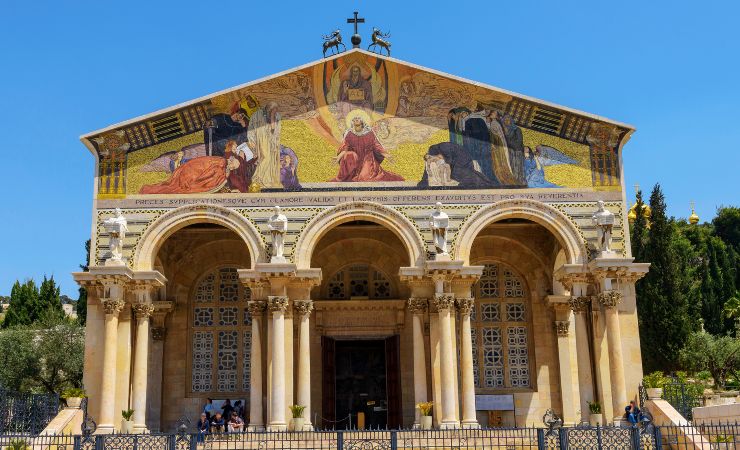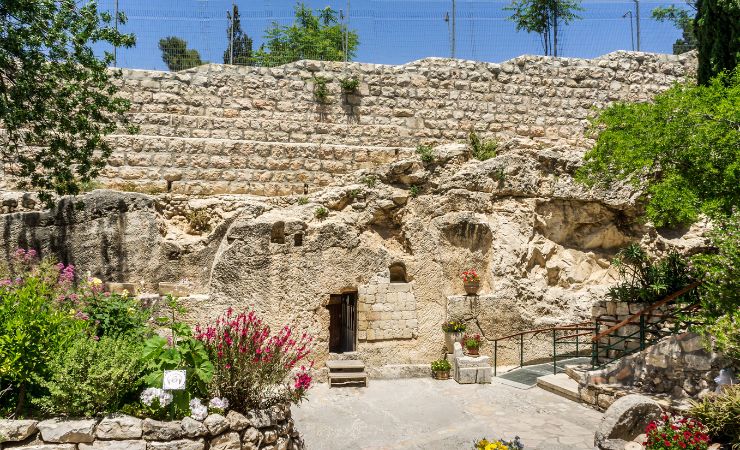Exploring the Historical Depth of Jerusalem's Church of the Redeemer
Originally published: June 2023 | Last updated: May 2025
Encapsulated within the heart of Jerusalem stands the Church of the Redeemer. A protestant church inaugurated in 1898, it is an enduring testament to the rich tapestry of faith that forms the city’s spiritual landscape.
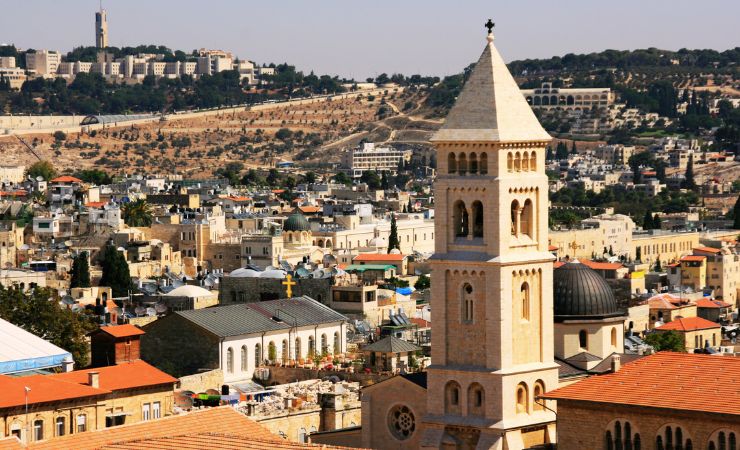
Location
In the labyrinthine alleys of the Christian Quarter of Jerusalem’s Old City, the Church of the Redeemer offers a peaceful respite. Its striking Neo-Romanesque architecture is an integral part of the city’s skyline, a stone’s throw from the revered Church of the Holy Sepulchre.
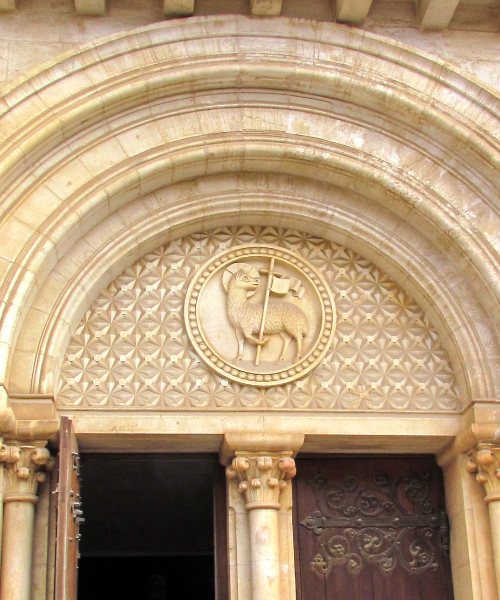
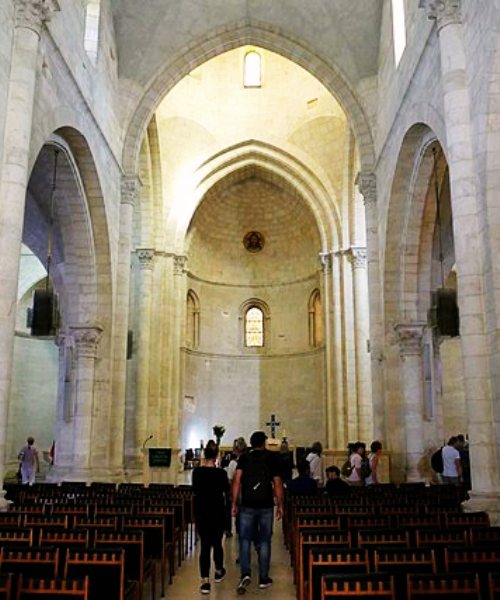
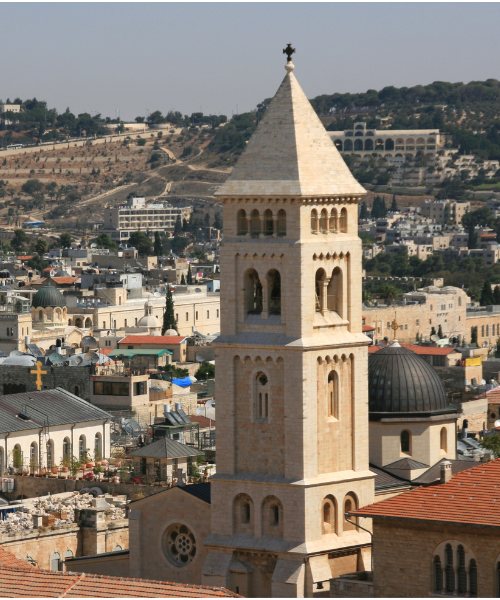
The Church of the Redeemer: Historical Context
Built on the remains of the Santa Maria Latina Church
Before embarking on the tale of the Church of the Redeemer, we must journey back to the 12th century, to the days of the Church of Santa Maria Latina.
The Crusaders established Santa Maria Latina at the turn of the 12th century during the Kingdom of Jerusalem. Despite its small size, it held a critical position within the city, a very close to the Church of the Holy Sepulchre. It had a simple basilica-style layout, a single apse, and a wooden roof. However, the decline of the Latin Kingdom marked the fall of Santa Maria Latina. By the end of the 12th century, Jerusalem had fallen to Saladin, and the church was abandoned.
Birth of the Church of the Redeemer
Fast forward to the 19th century; Jerusalem’s cityscape was undergoing another shift. As the Ottoman Empire embraced an era of reform, foreign powers were given liberties to establish their religious and cultural footprints in Jerusalem.
Designed by German architect Paul Ferdinand Groth, the construction of the church began in 1893 and completed in 1898. Its design was an echo of European Romanesque architecture with its round arches and robust pillars, blending effortlessly with the city’s visual language. The church was inaugurated on Reformation Day, October 31, 1898, in the presence of Kaiser Wilhelm II and his wife Augusta Victoria. The Kaider and his wife entered the old city in a procession through the newly renovated Jaffa Gate.
The Architecture of the Church of the Redeemer in Jerusalem: Blending History and Modernity
Resurrected in the late 19th century, the modern church’s design reflects the distinct characteristics of Neo-Romanesque architecture, interwoven with the traditional architectural elements of Jerusalem.
Exterior Architecture
The Church of the Redeemer is built in the Romanesque Revival style, drawing clear inspiration from twelfth-century Crusader churches. Its cruciform layout and stone facade fit naturally within the surrounding architecture of Jerusalem’s Old City.
The most recognizable feature is the tall, square bell tower rising 48 meters above street level, offering panoramic views across Jerusalem. The west-facing entrance, overlooking Muristan Street, features carved religious and national symbols: the Lamb of God, the Prussian eagle, and the Maltese cross. These motifs reflect the church’s Lutheran identity as well as its imperial German sponsorship.
The western façade includes a large rose window and modern Gothic detailing, possibly added at the suggestion of Emperor Wilhelm II. The building’s overall structure, however, remains firmly within the Romanesque tradition, with round arches, small paired windows, and a basilica-style arrangement of nave and aisles.
Interior Design
Inside, the church presents a more austere design. The nave is flanked by side aisles, leading to a semi-circular apse. While the original interior was more ornate—featuring wall paintings, mosaics, and a distinctive altar and pulpit—renovations in the 1970s led to a simplified appearance. These changes, overseen by architect Ernst W. Krueger, removed most of the decorative elements and left the stone walls exposed, aiming for a clean and unified modern style.
One mosaic of Christ and the apse window survive from the earlier interior. The stained glass windows, added during the renovation and designed by Anna Andersch-Marcus, bring soft light into the space. Created using fused glass, they are intended to support quiet reflection and readability, with themes linked to Psalm 130:1–2. The organ, located on a loft above the entrance, was also installed during this renovation period. While the stripped-down interior has been described by some as less inviting than its original form, it reflects a deliberate aesthetic aligned with post-war Lutheran ideals.
The new church’s floor was built approximately two meters above the level of the original, and its foundations extend deep below to the bedrock. Steps take you down to the archaeological park “Durch die Zeiten” (“Through the centuries”), which is located below the nave of the church. This park was created from archaeological excavations conducted on the site.
The excavations went down to bedrock as much as 14 meters under the Church of the Redeemer. Remnants visible in this area include: A Herodian quarry, buildings from the period of the Roman Emperor Hadrian, and mosaics from the Crusader Church of Saint Maria Latina.
Integrating the Remains of St. Maria Latina
What sets the Church of the Redeemer apart is its physical and visual integration of the earlier Church of St. Maria Latina, a Crusader-era structure built by the Order of St. John in the twelfth century. Though largely ruined by the 19th century, parts of the Crusader church remained visible, and these were incorporated into the new church’s design. Architect Friedrich Adler used the footprint and surviving elements of St. Maria Latina as a guide for the new church’s layout and style.
One of the most notable preserved features is a Romanesque arch from the Crusader church, now visible inside the north entrance of the modern church. The arch includes fragments of a medieval agricultural calendar, with months like November and December still legible.
Additional Information
Circa 1100 BCE: Area where the Church of the Redeemer now stands is outside the city walls, the traditional site of Golgotha (the crucifixion and burial site of Jesus).
2nd Century AD: The Roman Forum is constructed in the area by the Roman Emperor Hadrian. This becomes the religious and political center of the Roman city of Aelia Capitolina (Jerusalem).
Circa 1070 CE: The Church of the St. Mary of the Latins is first built.
1099: Italian church and hospice in the area function as a hostel and hospital for wounded Crusaders during the conquest of Jerusalem. Monks from the Benedictine order tend to the sick and wounded.
12th Century: The Benedictine group evolves into the Knights Hospitallers of St. John (the Hospitallers), officially established in 1113. They purchase and renovate the nearby Church and monastery of St. John the Baptist. Their headquarters in the Holy Land, including living quarters and hospital structures, are located around the area known as “Muristan” (based on the Persian word for hospital). The Hospitallers become an important military order.
Circa 1150 CE: The Church of the St. Mary of the Latins is rebuilt by the Crusaders, becoming the monastic church of the Hospitallers.
1187 CE: Jerusalem falls to Saladin. The Hospitaller’s headquarters in the Holy Land cease to function.
1267: The “Hospitallers quarter” (the Muristan area) is ruined after the Mamlukes conquest.
1839: The monastery of St. John the Baptist is renovated by the Greek Orthodox church.
Mid-19th Century: Liberal reforms begin in the Ottoman Empire. Missionary societies settle in Jerusalem. Protestant movements show renewed interest in the Holy Land.
1852: A pastor begins serving the German-speaking Protestant congregation in Jerusalem.
1857: Prussian King Friedrich Wilhelm IV, who had revived the Protestant branch of the Knights of St. John, expresses interest in acquiring the Muristan, the founding place of the Order of St. John.
1865: A photograph shows some walls and apses of the medieval Saint Mary of the Latins church still standing.
1869: Crown Prince Friedrich Wilhelm Nikolaus of Prussia (later King Friedrich III) oversees activity in Jerusalem. Sultan Abdülaziz of the Ottoman Empire gifts the eastern part of the Muristan to the friendly Crown Prince Friedrich Wilhelm. King Wilhelm I of Prussia (later Kaiser Wilhelm I) receives this land from Sultan Abdülhamid on the occasion of the inauguration of the Suez Canal. Friedrich commissions architect Friedrich Adler to plan the reconstruction of the Church of S. Maria Latina as the church of the newly founded Order of St. John. Crown Prince Friedrich Wilhelm visits Jerusalem and the eastern area of the Muristan is given to him as a present.
1871: The first chapel (St. John) is erected at the site. The German-speaking Protestant congregation begins convening in the Muristan Chapel. Carl Hoffmann is ranked provost.
1892-1898: The German Protestant Church of the Redeemer is constructed on the gifted land in the Muristan, designed by Paul Ferdinand Groth following designs by Friedrich Adler. Initially, the decision was made to reconstruct the Crusader-period Church of St. Maria Latina, but excavations led by Conrad Schick and others determined a new building was more feasible.
1893: The cornerstone for the new Church of the Redeemer is laid on behalf of the German Kaiser. Conrad Schick finds a wall under the name of St. Maria Latina that he interprets as the city wall from the time of Herod the Great, and the foundation stone is set on this. Construction of the Church of the Redeemer begins.
Reformation Day, October 31, 1898: Kaiser Wilhelm II personally dedicates the new Church of the Redeemer in the presence of the imperial family. The Kaiser and his wife enter the Old City through specially made ceremonial arches, including one from the Ottoman Empire, and via the newly renovated Jaffa Gate. Paul Hoppe is ranked provost since this year.
Ongoing: The Church of the Redeemer houses Lutheran congregations worshipping in Arabic, German, Danish, and English. It serves as the seat of the Provost of the German Protestant Ministries in the Holy Land and the headquarters of the Bishop of the Evangelical Lutheran Church in Jordan and the Holy Land.
Nearby Sites
- Church of the Holy Sepulchre: The possible site of Jesus’s crucifixion and resurrection, it’s a focal point of Christian faith worldwide.
- The Alexander Nevsky Church: A captivating Russian Orthodox Church, recognized for its distinctive green domes and richly decorated interior.
- Via Dolorosa: It’s believed to be the path that Jesus walked, carrying His cross, on the way to His crucifixion. The Via Dolorosa starts at the Lion’s Gate and passes a few sites of interest including the St. Annes Church, The Pool of Bethesda, the Church of Condemnation, the Ecce Homo Arch and more.
- Western Wall: The remnants of the Jewish Second Temple, the Western Wall is a symbol of perseverance and a sacred place of prayer.

